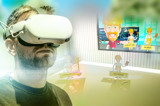The challenge
How to increase risk awareness?
Ørsted wished to increase their technicians’ overall risk awareness and understanding – they wanted to change people's perception of risks.
XXX
XX, Ørsted
The solution
Experience risks the safe way
The primary goal of the solution was to provide realistic risk awareness training by drawing inspiration from real incidents. And what better way to do that than using VR as a digital platform?
The plot
You have lost your memory, and you find yourself caught in a limbo between life and death.
Limbo - your subconscious helper – will help you return to life and re-construct the threads of your experiences and memories – since you need them to keep yourself and your colleagues safe and avoid accidents in the future.
The VR training will include seven life-like, interactive, immersive, and surprising risk awareness scenarios.
The first three VR training scenarios are already live on Ørsted’s sites, and we will create the following four life-like training scenarios in phase two, which we have just entered.
Why VR for this solution?
One of the biggest misconceptions about using virtual reality for learning is that it is a passive tool for content consumption.
Study shows that experiences are experiences – no matter if you experience in the real or the virtual world, the experience is captured in your mind and body the same way. And because our virtual body and behaviour can positively impact what our body does in the real world, we utilised the benefits of VR for this immersive, emotional, and behaviour-changing kind of training.
The evaluation
What does the target audience think?
Together with Ørsted, we have tested the VR training scenarios on the target audience ongoingly to adjust and finetune – and to make the scenarios as attention-grabbing, immersive, and close to reality as possible.
This is what the target audience thinks of training their risk awareness in VR:
I'm much more focused in this type of learning than I normally am - I definitely see the purpose of using VR in training.
Test person within target group, Technician, Ørsted
VR provides a good learning environment - you sort of shut out all other thoughts and focus only on the learning.
Test person within target group, Technician, Ørsted
I believe any kind of training sticks better when you see and experience it yourself - so I think I'll remember this VR training better in the future.
Test person within target group, Technician, Ørsted
VR can show reality as it is - neither more or less. So, I can easily see the potential of using VR for training purposes.
Test person within target group, Technician, Ørsted
More scenarios to come
The first three VR training scenarios are already live on Ørsted’s sites, and we will create the following four life-like training scenarios in phase two, which we have just entered.
We are very excited to see and hear how technicians will receive this new way of training – but looking at our tests, it looks very promising.
Rasmus Padkær Jørgensen, Senior Specialist, QHSE Enterprise Risk, EPCO & IT, Ørsted
The perspective
Immerse the user and make an impression
We use VR for multiple purposes; for example, to enhance the learning experience and the practical and emotional understanding of scenarios that are difficult to replicate. We also use VR to create impressive exhibition/marketing materials that give your target audiences a deeper understanding of your product or solution.
PSST… THERE’S MORE.













